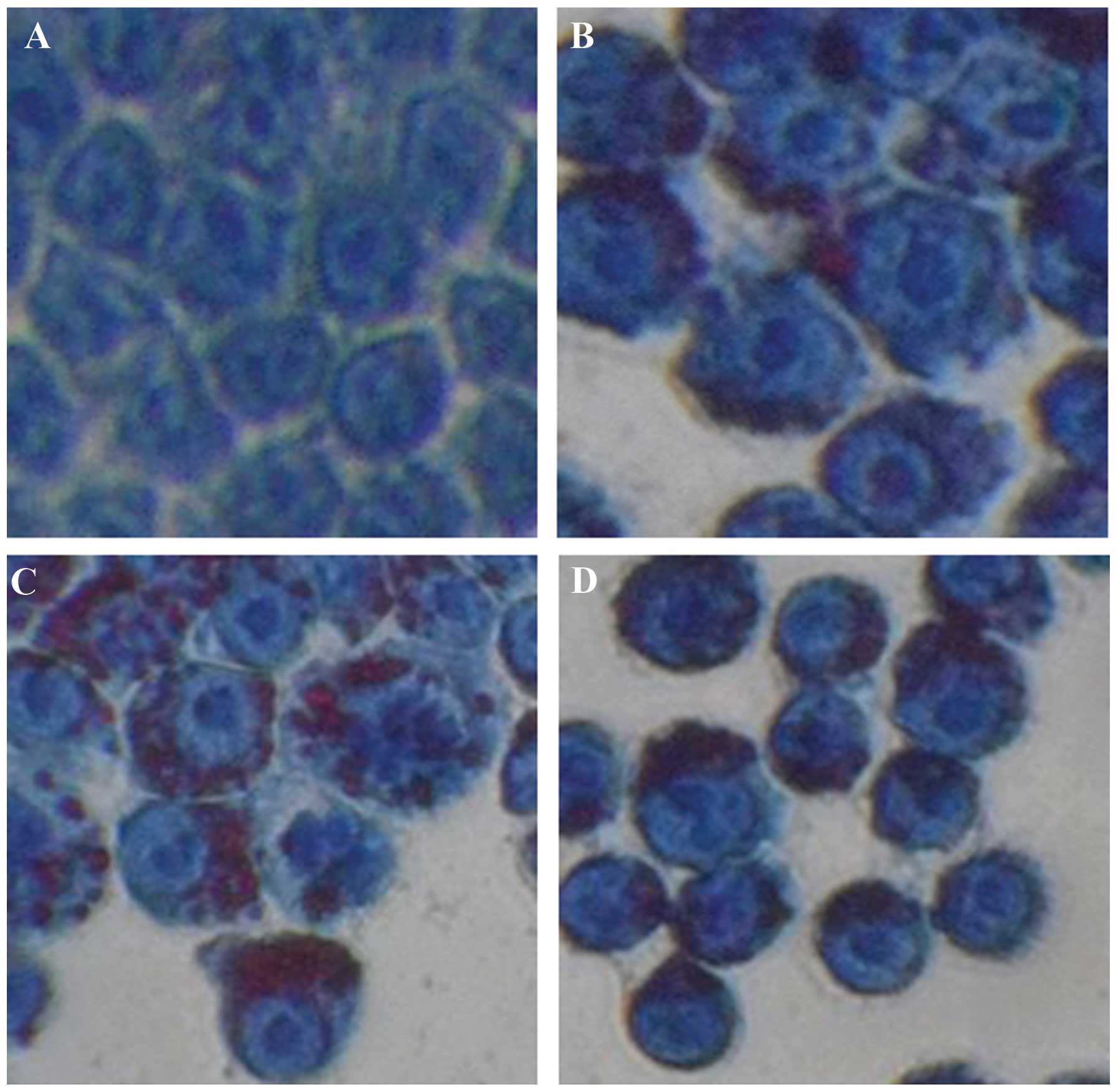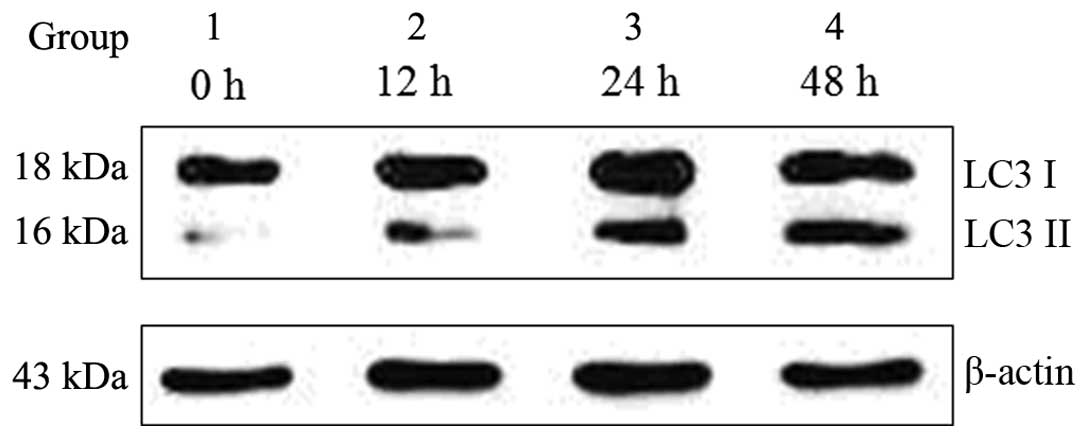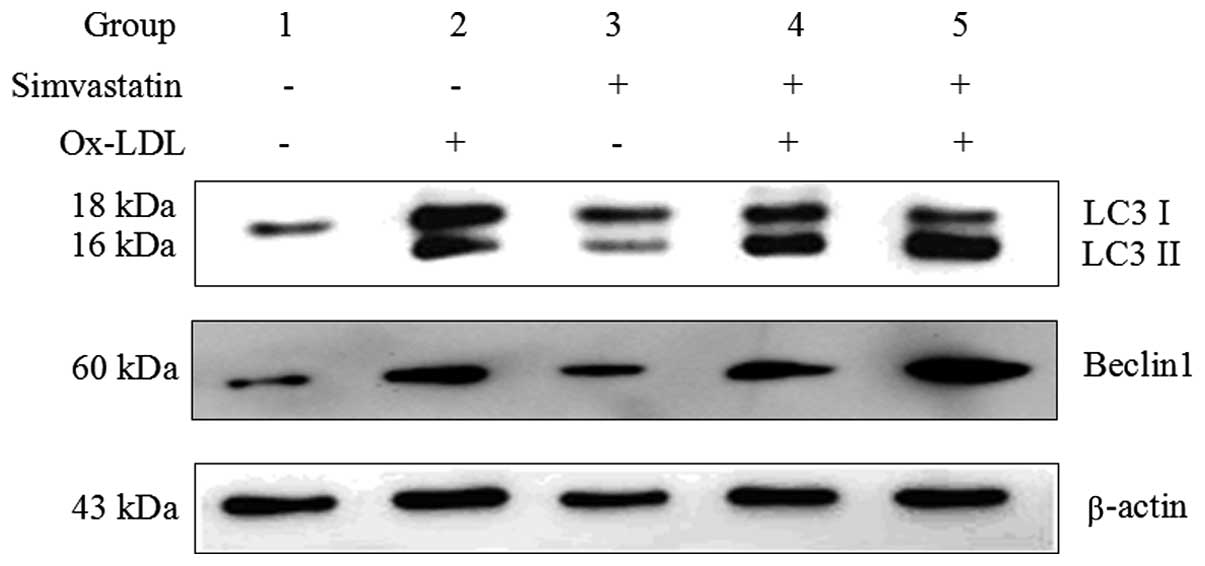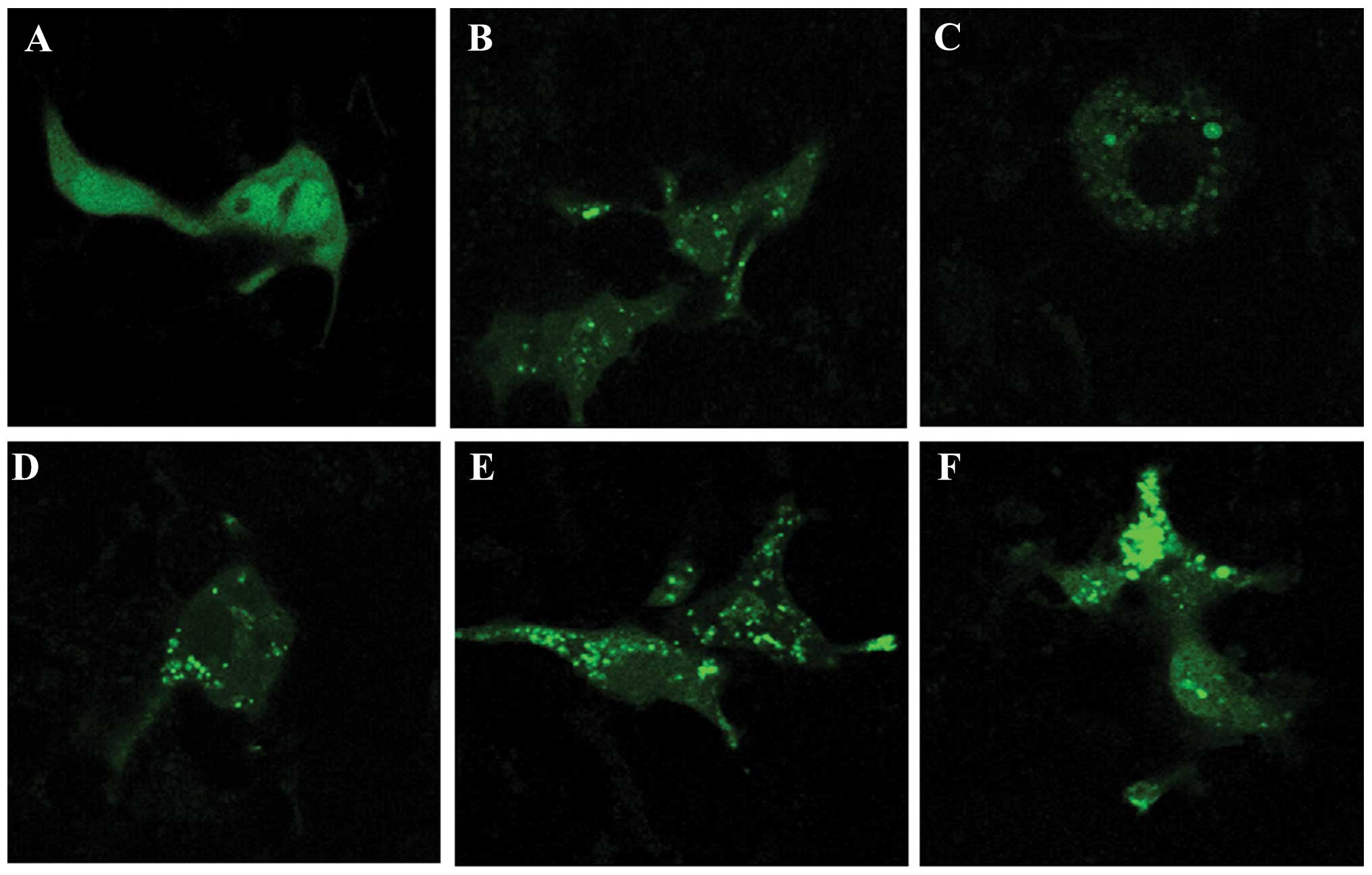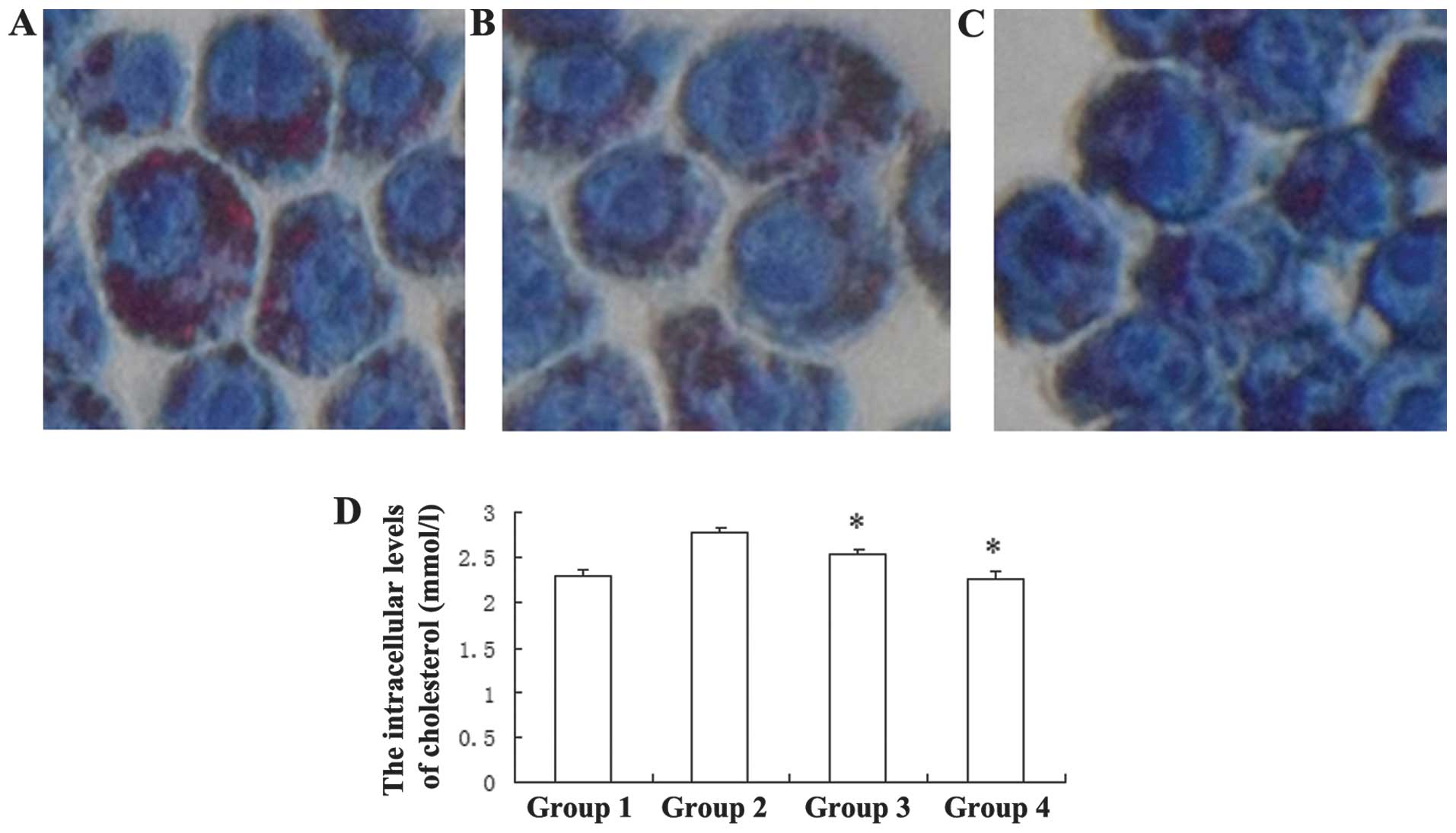Simvastatin enhances oxidized‑low density lipoprotein‑induced macrophage autophagy and attenuates lipid aggregation
- Authors:
- Published online on: October 27, 2014 https://doi.org/10.3892/mmr.2014.2790
- Pages: 1093-1098
Abstract
Introduction
Activation, dysfunction and structural alterations of the arterial endothelium results in the subendothelial retention of oxidized low-density lipoprotein (ox-LDL) from the plasma, thereby promoting the development and progression of atherosclerosis (1). Activated endothelial cells secrete chemokines, and subsequently express adhesion molecules, which may facilitate the recruitment of leukocytes, from the blood into the arterial wall (2). Of the leukocytes, monocytes are a critical cell type that contribute to the formation of atherosclerotic plaques. In the intima, migrated monocytes differentiate into macrophages, which engulf ox-LDL to form cholesterol-laden foam cells (3).
Autophagy is a conserved catabolic process in which cytoplasmic material is delivered to the lysosomal machinery for degradation and recycling. It is well-known that autophagy occurs in advanced atherosclerotic plaques (4–6), and that macrophage autophagy exerts a protective effect in advanced atherosclerosis (7). Previous studies have shown that ox-LDL may induce autophagy in endothelial cells, leading to the degradation of ox-LDL through autolysosomes (8,9). However, little is currently known about whether ox-LDL may induce autophagy in macrophages.
Statins are inhibitors of 3-hydroxy-3-methylglutaryl-coenzyme A (HMG-CoA) reductase. Statins impede cholesterol biosynthesis, therefore reducing blood cholesterol levels. As well as lowering lipid levels, statins have been demonstrated to possess pleiotropic effects, including anti-inflammatory and immunomodulatory properties (10,11). Simvastatin is a widely used statin, that exhibits lipid and non-lipid effects (12,13). Recently, simvastatin was shown to enhance autophagy in coronary arterial myocytes, through inhibition of the Rac1-mammalian target of rapamycin (mTOR) signaling pathway (14). However, the effects of simvastatin on macrophage autophagy remain unclear.
The present study examined whether ox-LDL may induce autophagy in macrophages, and explored the role of simvastatin in ox-LDL-induced macrophage autophagy and lipid accumulation.
Materials and methods
Cell culture and reagents
The J774A.1 murine macrophage cell line was purchased from the China Center for Type Culture Collection (Wuhan, China). The cells were maintained in RPMI-1640 medium (Thermo Fisher Scientific, Co., Waltham, MA, USA), supplemented with 10% fetal calf serum (Zhejiang Tianhang Biological Technology Co., Ltd., Hangzhou, China), at 37°C in an atmosphere containing 5% CO2. Ox-LDL was purchased from Yiyuan Biotechnology Co., Ltd (Guangzhou, China). Simvastatin was purchased from Tokyo Chemical Industry Co., Ltd (Shanghai, China). Oil Red O dye and Total Cholesterol Detection kit were purchased from Nanjing Jiancheng Biotechnology Institute Co., Ltd (Nanjing, China). Lipofectamine® 2000 was obtained from Life Technologies (Grand Island, NY, USA). Rabbit anti-microtubule-associated protein 1 light chain 3(LC3) and rabbit anti-Beclin1 antibodies were purchased from Cell Signaling Technology, Inc. (Danvers, MA, USA). Horseradish peroxidase (HRP)-labeled goat anti-rabbit Immunoglobulin G was purchased from Beijing ZSGB-Biotechnology, Co. (Beijing, China). The Bicinchoninic Acid (BCL) Protein Assay kit was obtained from Beijing YPH-Bio Company (Beijing, China), and the Enhanced Chemiluminescence (ECL) Detection system was purchased from Pierce Biotechnology, Inc. (Rockville, MD, USA).
Establishment and detection of macrophage foam cell model
The J774A.1 cells were seeded into 6-well plates (5×105 cells per well) and grown to 50–60% confluency. A total of 0, 25, 50 or 100 μg/ml ox-LDL was added to the cell supernatants, and the cells were incubated for 24 h. The cells were washed with phosphate-buffered saline and fixed with formaldehyde. The fixed cells were stained with oil Red O dye, for 30 min at 37°C. The status of intracellular lipid accumulation was detected by microscopy (Olympus CKX41; Olympus, Tokyo, Japan), in order to assess the formation of macrophage foam cells.
Western blotting
The J774A.1 cells were plated in 6-well plates and grown to 50–60% confluency. Following stimulation with ox-LDL (or/and simvastatin at 0.5 and 1.0 μM), the cells were harvested and lysed with RIPA lysis buffer on ice. The cell lysates were centrifuged at 13,000 g for 30 min at 4°C. The protein concentrations of the supernatants were determined using the BCA kit. Equal quantities of protein (30 μg) from the homogenized samples were separated by 15% SDS-PAGE, and transferred to polyvinylidene fluoride membranes (Millipore, Boston, MA, USA). The membranes were blocked with tris-buffered saline-Tween® (TBST), containing 5% non-fat milk powder, for 2 h at room temperature. The membranes were then incubated with polyclonal rabbit anti-microtubule-associated protein 1 light chain 3(LC3; 1:1,000) and polyclonal rabbit anti-Beclin1 (1:1,000) primary antibodies at 4°C overnight, washed with TBST, and incubated for 1 h with HRP-conjugated goat anti-rabbit antibody (1:10,000 dilution), at room temperature. β-actin was used as a control. Immunoreactive bands were visualized using the ECL detection system and images were captured using an automatic digital gel image analysis system (4500SF; Tanon Science & Technology Co., Ltd., Shanghai, China).
Confocal laser scanning microscopy
Green fluorescent protein (GFP)-LC3 plasmids were previously prepared in our laboratory (15) and were transfected into the J774A.1 cells, using Lipofectamine® 2000 according to the manufacturer’s instructions. The cells were treated with ox-LDL (and/or simvastatin) 24 h post-transfection, and incubated for a further 24 h. All GFP-LC3 plasmid-transfected cells with or without ox-LDL (and/or simvastatin) treatment were then fixed using Immunol Staining Fix Solution (Beyotime Institute of Biotechnology, Haimen, China) and GFP-LC3 fluorescence was detected by confocal laser scanning microscopy (Leica TCS SP5; Leica, Mannheim, Germany).
Measurement of intracellular cholesterol using the CHOD-PAP method
Following stimulation with ox-LDL (or/and simvastatin), the cells were harvested and sonicated on ice for a total of 5 sec, with 15 sec pauses between bursts using a sonicator (Ningbo Scientz Biotechnology Co., Ltd., Ningbo, China). Following sonication for 10 min, the cells were centrifuged at 8,000 g for 10 min at 4°C. The supernatants were then used for measurement of intracellular cholesterol. Total cholesterol levels in the cells were determined by the CHOD-PAP method, using the Total Cholesterol Detection kit (Nanjing Jiancheng Biotechnology Institute Co., Ltd.), according to the manufacturer’s instructions.
Statistical analysis
The data are represented as the mean ± standard deviation, and were statistically analyzed using SPSS 13.0 software (SPSS Inc., Chicago, IL, USA). Statistical analysis was performed using Student’s t-test to compare the differences between two groups. P<0.05 was considered to indicate a statistically significant difference.
Results
Ox-LDL induces lipid accumulation in macrophages
To investigate the possible roles of simvastatin on ox-LDL-induced macrophage autophagy and lipid accumulation, a macrophage foam cell model was generated. Groups A, B, C and D of the J774A.1 cells were treated with 0, 25, 50 and 100 μg/ml ox-LDL respectively, for 24 h, and the status of lipid accumulation was determined by oil red O staining. No obvious lipid accumulation was observed in the control group (Fig. 1A). Conversely, lipid accumulation was observed in all of the groups treated with ox-LDL (Fig. 1B–D). Lipid accumulation was more visible in groups C and D, as compared with group B, implying the existence of a dose-dependent effect. All of the cells treated with ox-LDL had similar morphological characteristics to foam cells, suggesting the successful establishment of a macrophage foam cell model. Thereafter, 50 μg/ml ox-LDL was selected to treat cells in further experiments.
Ox-LDL induces the transformation of LC3 I to LC3 II in macrophages
Ox-LDLs have previously been shown to trigger autophagy in endothelial cells (8,9,16). The present study examined whether ox-LDL induced autophagy in macrophages. Ox-LDL (50 μg/ml) induced autophagy in the J774A.1 macrophage cell line by converting LC3 I to LC3 II, which is a well-known autophagy marker. The transformation of LC3 I to LC3 II increased gradually, in a time-dependent manner following treatment with 50 μg/ml ox-LDL, as compared with the control group (Fig. 2).
Simvastatin enhances ox-LDL-induced macrophage autophagy
Simvastatin was previously shown to enhance autophagy in osteoblastic cells and coronary arterial myocytes (14,17). The present study determined whether simvastatin elevated ox-LDL-induced autophagy in macrophages. Concordant with the results presented in Fig. 2, the protein expression levels of the autophagy marker LC3 II were induced in group 2, following stimulation with 50 μg/ml ox-LDL for 24 h (Fig. 3). Notably, treatment with simvastatin markedly promoted the conversion of LC3 I to LC3 II (group 4 and 5, as compared with group 2). Treatment with 1.0 μM simvastatin enhanced ox-LDL-induced LC3 II expression more than treatment with 0.5 μM simvastatin, suggesting that simvastatin affects ox-LDL-induced autophagy in a dose-dependent manner (Fig. 3). Simvastatin (0.5 and 1.0 μM) also increased the expression levels of another ox-LDL-induced autophagy marker, Beclin1 (Fig. 3).
The GFP-LC3 plasmid was used to detect autophagosome formation. Stimulation with ox-LDL led to the redistribution of GFP-LC3, from diffusion distribution to puncta in the J774A.1 cells, as determined by confocal laser scanning microscopy (Fig. 4A and B). Treatment with simvastatin (0.5 and 1.0 μM) alone resulted in the formation of GFP-LC3 fluorescent puncta in the J774A.1 cells (Fig. 4C and D). Furthermore, treatment with simvastatin markedly promoted the ox-LDL-induced formation of GFP-LC3 puncta (Fig. 4E and F). Treatment with 1.0 μM simvastatin enhanced the formation of ox-LDL-induced GFP-LC3 puncta more so than 0.5 μM simvastatin (Fig. 4E and F). These results indicate that simvastatin may enhance ox-LDL-induced macrophage autophagy.
Simvastatin inhibits ox-LDL-induced cholesterol accumulation in macrophages
As a HMG-CoA reductase inhibitor, simvastatin is a well-known drug used to ameliorate atherosclerotic diseases, by lowering plasma cholesterol. The present study determined whether simvastatin may inhibit ox-LDL-induced cholesterol accumulation in J774A.1 cells. The number of lipid droplets, the existing form of cholesterol in cells, decreased following incubation with simvastatin (Fig. 5A–C). The CHOD-PAP assay indicated that treatment with 0.5 and 1.0 μM simvastatin led to a significant reduction in the intracellular total cholesterol levels, from 2.774±0.059 mmol/l, to 2.53±0.058 mmol/l and 2.27±0.085 mmol/l, respectively (Fig. 5D). These results suggest that simvastatin may inhibit ox-LDL-induced cholesterol accumulation in macrophages.
Discussion
Ox-LDL has a pivotal role in atherosclerosis initiation and progression. Ox-LDL may be recognized and engulfed by macrophages through scavenger receptors, leading to the formation of foam cells, which are the prominent feature of atherosclerotic lesions (18,19). As predicted, the results of the present study demonstrated that ox-LDL was capable of inducing lipid accumulation in J774A.1 cells, indicating the formation of foam cells. Previous studies have shown that ox-LDL may induce autophagy in endothelial cells (8,9,16,20). However, it is relatively difficult to observe autophagy in macrophages, since they are phagocytic and the cytoplasmic vacuoles render it difficult to distinguish between autophagocytosis and heterophagocytosis (4). Ouimet and Marcel (21) reported that acetylated-LDL elevated macrophage intracellular cholesterol levels, and were delivered to the lysosomes by autophagy (21). Concordant with these results, the present study demonstrated that ox-LDL induced autophagy in macrophages, by increasing the expression of LC3 II and Beclin1, the classic autophagy markers.
As a powerful lipid-lowering drug, simvastatin is widely used for the treatment of atherosclerosis. Accumulating evidence has shown that simvastatin also has various other effects. The present study reported that, besides decreasing ox-LDL-induced cholesterol accumulation, simvastatin intensified ox-LDL-induced macrophage autophagy. However, it remains noteworthy that drugs may directly induce macrophage autophagy in atherosclerosis, and certain drug-induced macrophage autophagy promotes a stable plaque phenotype (22). The results of the present study showed that simvastatin may directly induce macrophage autophagy, albeit only marginally. Whether this effect may have a role in plaque progression requires further investigation.
In mammalian cells there are two types of autophagy: mTOR-dependent and mTOR-independent autophagy (22). Wei et al (14) demonstrated that simvastatin induced autophagy through inhibition of Rac1-mTOR signaling in coronary arterial myocytes. However, it remains unknown whether simvastatin promotes ox-LDL-induced macrophage autophagy in the same way. Further studies are required to explore whether ox-LDL-induced macrophage autophagy is mTOR-dependent or not. In addition, the results of the present study were obtained from in vitro experiments. An animal model of atherosclerosis may be useful to confirm these findings.
In conclusion, the results of the present study suggest that ox-LDL is capable of inducing autophagy in macrophages, and simvastatin may enhance ox-LDL-induced macrophage autophagy and attenuate lipid accumulation. These results imply that macrophage autophagy in atherosclerosis may be the potential target of simvastatin for plaque stabilization.
Acknowledgements
The present study was supported by grants from the National Natural Science Foundation of China Grants (grant no. 30972791, to Baojun Huang) and the Research Fund of Anhui Medical University (grant no. 0116025101, to Songcheng Ying).
References
|
Legein B, Temmerman L, Biessen EA and Lutgens E: Inflammation and immune system interactions in atherosclerosis. Cell Mol Life Sci. 70:3847–3869. 2013. View Article : Google Scholar : PubMed/NCBI | |
|
Cybulsky MI, Won D and Haidari M: Leukocyte recruitment to atherosclerotic lesions. Can J Cardiol. 20:24B–28B. 2004.PubMed/NCBI | |
|
Moore KJ, Sheedy FJ and Fisher EA: Macrophages in atherosclerosis: a dynamic balance. Nat Rev Immunol. 13:709–721. 2013. View Article : Google Scholar : PubMed/NCBI | |
|
Martinet W and De Meyer GR: Autophagy in atherosclerosis. Curr Atheroscler Rep. 10:216–223. 2008. View Article : Google Scholar : PubMed/NCBI | |
|
Martinet W and De Meyer GR: Autophagy in atherosclerosis: a cell survival and death phenomenon with therapeutic potential. Circ Res. 104:304–317. 2009. View Article : Google Scholar : PubMed/NCBI | |
|
Schrijvers DM, De Meyer GR and Martinet W: Autophagy in atherosclerosis: a potential drug target for plaque stabilization. Arterioscler Thromb Vasc Biol. 31:2787–2791. 2011. View Article : Google Scholar : PubMed/NCBI | |
|
Liao X, Sluimer JC, Wang Y, Subramanian M, Brown K, Pattison JS, Robbins J, Martinez J and Tabas I: Macrophage autophagy plays a protective role in advanced atherosclerosis. Cell Metab. 15:545–553. 2012. View Article : Google Scholar : PubMed/NCBI | |
|
Zhang YL, Cao YJ, Zhang X, Liu HH, Tong T, Xiao GD, Yang YP and Liu CF: The autophagy-lysosome pathway: a novel mechanism involved in the processing of oxidized LDL in human vascular endothelial cells. Biochem Biophys Res Commun. 394:377–382. 2010. View Article : Google Scholar : PubMed/NCBI | |
|
Muller C, Salvayre R, Nègre-Salvayre A and Vindis C: HDLs inhibit endoplasmic reticulum stress and autophagic response induced by oxidized LDLs. Cell Death Differ. 18:817–828. 2011. View Article : Google Scholar : | |
|
Almuti K, Rimawi R, Spevack D and Ostfeld RJ: Effects of statins beyond lipid lowering: potential for clinical benefits. Int J Cardiol. 109:7–15. 2006. View Article : Google Scholar | |
|
Bu DX, Griffin G and Lichtman AH: Mechanisms for the anti-inflammatory effects of statins. Curr Opin Lipidol. 22:165–170. 2011. View Article : Google Scholar : PubMed/NCBI | |
|
Wierzbicki AS, Poston R and Ferro A: The lipid and non-lipid effects of statins. Pharmacol Ther. 99:95–112. 2003. View Article : Google Scholar : PubMed/NCBI | |
|
Marzilli M: Pleiotropic effects of statins: evidence for benefits beyond LDL-cholesterol lowering. Am J Cardiovasc Drugs. 10(Suppl 1): 3–9. 2010. View Article : Google Scholar : PubMed/NCBI | |
|
Wei YM, Li X, Xu M, Abais JM, Chen Y, Riebling CR, Boini KM, Li PL and Zhang Y: Enhancement of autophagy by simvastatin through inhibition of Rac1-mTOR signaling pathway in coronary arterial myocytes. Cell Physiol Biochem. 31:925–937. 2013. View Article : Google Scholar : PubMed/NCBI | |
|
Zhang M, Huang BJ, Hu MC, Chen YW, Song W, Huang DK, Li Q and Hu CS: Lipopolysaccharide induces formation of autophagy-related LC3B-GFP fluorescent aggregates in the RAW264.7 macropahge cells. J Anhui Medical Uni. 47:357–361. 2012.(In Chinese). | |
|
Nowicki M, Zabirnyk O, Duerrschmidt N, Borlak J and Spanel-Borowski K: No upregulation of lectin-like oxidized low-density lipoprotein receptor-1 in serum-deprived EA.hy926 endothelial cells under oxLDL exposure, but increase in autophagy. Eur J Cell Biol. 86:605–616. 2007. View Article : Google Scholar : PubMed/NCBI | |
|
Lai EH, Hong CY, Kok SH, Hou KL, Chao LH, Lin LD, Chen MH, Wu PH and Lin SK: Simvastatin alleviates the progression of periapical lesions by modulating autophagy and apoptosis in osteoblasts. J Endod. 38:757–763. 2012. View Article : Google Scholar : PubMed/NCBI | |
|
Maiolino G, Rossitto G, Caielli P, Bisogni V, Rossi GP and Calò LA: The role of oxidized low-density lipoproteins in atherosclerosis: the myths and the facts. Mediators Inflamm. 2013:7146532013. View Article : Google Scholar : PubMed/NCBI | |
|
Mitra S, Goyal T and Mehta JL: Oxidized LDL, LOX-1 and atherosclerosis. Cardiovasc Drugs Ther. 25:419–429. 2011. View Article : Google Scholar : PubMed/NCBI | |
|
Ding Z, Wang X, Khaidakov M, Liu S, Dai Y and Mehta JL: Degradation of heparan sulfate proteoglycans enhances oxidized-LDL-mediated autophagy and apoptosis in human endothelial cells. Biochem Biophys Res Commun. 426:106–111. 2012. View Article : Google Scholar : PubMed/NCBI | |
|
Ouimet M and Marcel YL: Regulation of lipid droplet cholesterol efflux from macrophage foam cells. Arterioscler Thromb Vasc Biol. 32:575–581. 2012. View Article : Google Scholar | |
|
Martinet W, De Meyer I, Verheye S, Schrijvers DM, Timmermans JP and De Meyer GR: Drug-induced macrophage autophagy in atherosclerosis: for better or worse? Basic Res Cardiol. 108:3212013. View Article : Google Scholar |



